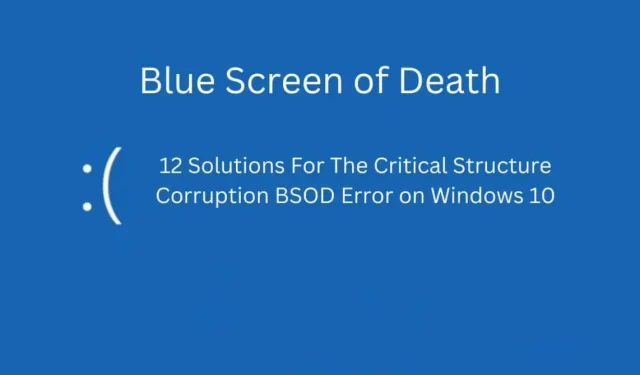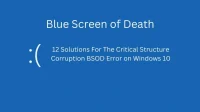You are using your computer to surf the web, launch a program or play a video and all of a sudden everything turns off and you see a blue screen saying that your computer has encountered a problem and needs to be restarted.
This is the blue screen of death error and many of its varieties. One of them is the Critical Structure Corruption error. You can see the name of the error at the bottom of the BSOD.
Causes of Critical Structure Corrupted BSOD Error
- A driver problem related to your computer’s kernel
- Problems with the power supply
- Corrupted system files
- Corrupted or outdated graphics drivers
- Bad sector on the hard drive or hardware failure
- Unsupported hardware or USB device connected to PC
- Overclocked CPU, RAM, or GPU
Best Fixes for Critical Structure Error in Windows 10
- Disable USB Devices
- Boot into safe mode
- Run the Memory Diagnostic Tool
- Scan hard drive and system files
- Update or uninstall your graphics driver
- Remove potentially problematic applications
- Perform a clean boot
- Use Microsoft’s online blue screen troubleshooter.
- Cancel Overclock
- Inspect the power supply unit (PSU)
- Update Windows and all device drivers
- Create a new user account
1. Disconnect USB devices
At the start of troubleshooting this BSOD error, it’s a good idea to remove as many variables from the equation as possible. So, disconnect all USB devices like mouse, keyboard, printers, flash drives and similar devices from PC and restart it.
For a computer, leave the mouse and keyboard connected and disconnect other devices.
2. Boot into safe mode
The Windows operating system comes with a built-in free utility that saves you from errors such as the Windows 10 critical structure corruption error. In Safe Mode, your Windows boots with only the necessary programs and drivers, excluding all other drivers.
Use these steps to boot Windows in safe mode:
- Turn on your computer and press and hold the power button when the Windows logo appears to turn it off.
- Start your PC again and do the same as above.
- When you turn your computer back on, Windows will load the Automatic Recovery Environment.
- On the “Your computer did not start correctly”screen, select “Advanced Options”.
- Navigate to Troubleshoot > Advanced Options > Startup Options.
- The next screen will show which settings will be enabled. Select Reload.
- When Windows boots up again, a blue screen will appear with various options. Press F4 on your keyboard to start Windows in safe mode.
3. Run the Memory Diagnostic Tool
RAM issues are known to cause system crashes and critical structure corruption in Windows 10. So, run the Windows Memory Diagnostic tool to check the memory status. This may fix some issues, and for some, you may need to replace your PC’s RAM.
- Open the start menu, type “memory diagnostic tool”and select the best option.
- Be sure to close and save your work and select “restart now and check for problems (recommended)”.
- Your computer will restart and the memory diagnostic tool will run automatically.
- Once this is done, Windows will boot normally and you will receive a memory diagnostic report in notifications. This will show if any bugs have been found and/or fixed.
- If the tool cannot resolve the issues, you will need new RAM.
4. Scan your hard drive and system files
There are three types of built-in Windows hard drive and file checking tools. And since we are dealing with critical structure corruption on Windows 10, we may need to use all three of them one at a time.
4.1 Checking the hard disk for errors (CHKDWe)
To easily check for disk errors, follow these steps:
- Open file manager.
- Go to “This PC”.
- Right-click on the local drive containing the Windows 10 installation files and select Properties.
- Go to the “Tools”tab.
- In the Error Checking section, click Check.
- If everything is in order, Windows will indicate that you do not need to run a scan. Select Scan Disk.
- After the scan is complete, if there are errors, the wizard will show you the steps you can take to fix them.
For more control, run this check on the command line:
- Open the start menu, type cmd and select “Run as administrator”.
- Copy and paste chkdsk /f /r C: and press enter.
- This will check for and fix C drive errors and bad sectors. It will take some time.
4.2 SFC scan
System File Checker also checks the file system of hard drives, but it is more focused on finding and fixing problems with the Windows file system.
- Open Start, type cmd and select Run as administrator.
- Type sfc /scannow and press Enter.
- Wait while the system files are checked and fixed.
4.3 DISM tool
If the SFC scan fails to repair the files, then you should use the DISM tool. Follow these steps:
- Open a command prompt with administrator rights.
- Use the commands below and press enter for each one:
- Dism /Online /Cleanup-Image /CheckHealth
- Dism /Online /Cleanup-Image /ScanHealth
5. Update or uninstall your graphics driver
Often critical structure corruption in Windows 10 is due to an outdated or faulty graphics driver. When the driver does not work properly, Windows crashes and displays a BSOD error.
Try updating your graphics driver:
- Right-click the Start logo on the taskbar and select Device Manager.
- Double-click Display Adapters, right-click your graphics device driver, and select Update Driver.
- Select “Search for Drivers Automatically”.
- It will search for drivers and install them if available.
- Restart your computer.
In cases where updating the drivers does not resolve the critical error, uninstall the GPU driver. Windows will automatically install it again. Also, if you are using a dedicated display driver application such as NVIDIA GeForce Experience, uninstall that as well.
- Follow the same steps as above, but when you right-click on your graphics device driver, choose Uninstall Device.
- Confirm the action and restart your computer.
6. Remove Potentially Problematic Apps
Some applications are reported to cause Windows BSOD errors. So, if you have installed Alcohol 120%, Intel HAXM, MacDriver or Daemon Tools, remove them.
- Go to Settings > Apps.
- Select the app you want to uninstall and click Uninstall.
7. Perform a clean boot
Clean boot allows you to remove all third-party applications that do not start when you boot Windows. This allows you to subtract if any installed program is causing critical structure corruption in Windows 10.
If your Windows is able to boot in safe mode, try performing a clean boot to see if the software issue is related to Windows files or third-party applications. Smooth operation during a clean boot will show you that the BSOD error is caused by third party software.
- Press the Windows logo + R to get the run command.
- Type msconfig and hit enter.
- Go to the “Services”tab.
- Check the “Hide all Microsoft services”box and click the “Disable all”button.
- Then go to the “Startup”tab and select “Open Task Manager”.
- Right-click each item and select Disabled.
- Close Task Manager and return to the System Configuration window.
- Click “Apply”and “OK”.
- Restart your computer.
- Now see if the PC is having any problems starting up. If not, follow the same steps, allow one third party app and restart your computer. Keep turning on one app each time to find out the culprit.
8. Use Microsoft’s Online Blue Screen Troubleshooter.
Windows 10 has a built-in BSOD troubleshooter, but it is no longer supported. But for diagnosing critical structure corruption BSOD error issues, you can still use the online blue screen troubleshooter.
- Go to the online blue and black screen troubleshooter.
- Answer the questions to get suggestions for fixing the bug.
9. Cancel overclocking
Overclocking can cause a lot of problems and fatal errors. So, when troubleshooting a BSOD error, take this factor out of the equation by reverting to default settings and undoing the RAM, CPU, and GPU overclocks.
10. Inspect the power supply (PSU)
In some cases, a damaged or low-quality cable can cause critical structure damage in Windows 10. Therefore, perform a hardware check on your computer and make sure that all wires are properly connected to the correct ports and not loose. Also, check for a damaged cable.
11. Update Windows and all device drivers
I showed you how to update or uninstall your display driver because it usually causes Blue Screen of Death errors. If your Critical Structure Corruption Error persists, update all drivers.
- Go to Settings > Update & Security.
- Click the “Check for Updates”button.
- Allow updates and then restart your computer.
- Now go to Settings > Update & Security again and click on Optional Updates.
- After that, select “Driver Updates”, check all drivers and click “Download and Install”.
12. Create a new user account
The problem may be related to the user account you normally use. When the user’s system files are missing or corrupted, a BSOD error occurs. Create a new account and try again. These steps are for creating a local account in Windows 10.
- Disconnected from the internet.
- Go to Settings > Accounts > Family & other users.
- Select Add someone to this PC.
- Enter your username and password.
- Select an account type.
- Restart your computer and sign in to your new account.
Conclusion
The most common cause of critical structure corruption in Windows 10 is faulty display drivers and hard drive issues. If the above solutions do not resolve the error, then you should reinstall Windows.


